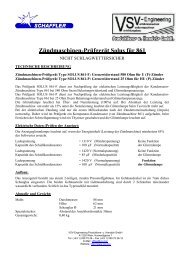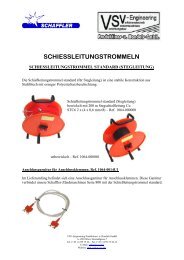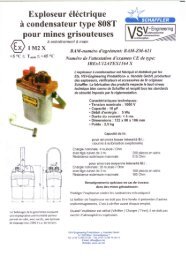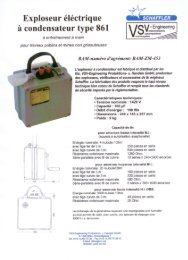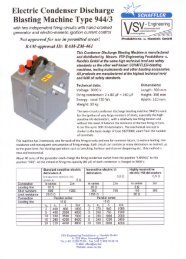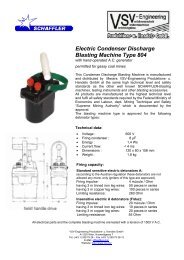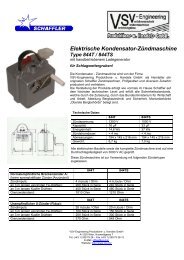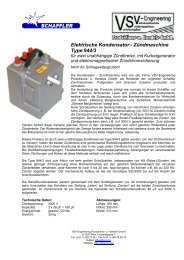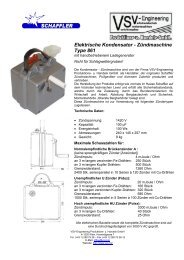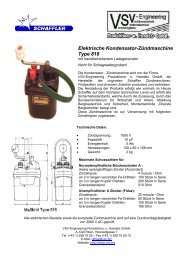Blasting Machine-Tester Solus for 808T - VSV - Engineering
Blasting Machine-Tester Solus for 808T - VSV - Engineering
Blasting Machine-Tester Solus for 808T - VSV - Engineering
Create successful ePaper yourself
Turn your PDF publications into a flip-book with our unique Google optimized e-Paper software.
<strong>Blasting</strong> <strong>Machine</strong>-<strong>Tester</strong> <strong>Solus</strong> <strong>for</strong> <strong>808T</strong>TECHNICAL DESCRIPTIONPERMITTED FOR GASSY COAL MINES<strong>Blasting</strong> machine tester type SOLUS <strong>808T</strong>: Limit resistance 195 Ohm <strong>for</strong> U (F)-detonatorsThe testing instrument SOLUS <strong>808T</strong> is applicable <strong>for</strong> testing the electric capacity of the condenser dischargeblasting machine type <strong>808T</strong> at 195 Ohm fixed load resistor and indication of the glow lamp. The glow lamplights if the capacity has reached the nominal value (100%) or more. When the capacity is reduced by more than15% under the nominal value the glow lamp does not light anymore during the test. For the electric blasting onlythe first milliseconds after the activation of the ignition current (impulse) are necessary. There<strong>for</strong>e in the testinginstrument a comparator condenser (of blasting machine <strong>808T</strong>) is charged, when the threshold voltage is reacheda thyristor will be switched by means of a diode and the glow lamp lights.Electric data (Testing of the indication):The indication of the glow lamp lights when the energy content (power of the blasting machine) reaches at least85% of the nominal value.Charging voltage = 922 V (less voltage) no functionCapacity of the firing condenser = 10 µF (normal capacity) of the glow lampCharging voltage = 1000 V (normal voltage) no functionCapacity of the firing condenser = 8,5 µF (less capacity) of the glow lampCharging voltage = 1000 V (normal voltage) functionCapacity of the firing condenser = 10 µF (normal capacity) of the glow lampConstruction:The housing is bipartite and is made of strong plastic. A 7 mm thick sight glass in the top of the housing enablesan observation of the indicating glow tube. Both housing parts are connected by means of two screws. The typelabel is fixed on the bottom of the lower part. A 1 m long cable connects the tester to the special plug, which isapplied to the terminals of the blasting machine. This plug is designed in such a manner to enable its connectiononly with the correct polarity.Measurement and weight:Measurement: Length 88 mmWidth35 mmHeight44 mmSight glass Ø 21 mmConnecting cable: Length 1 mSpecial plug:Distance of the plugs: 30 mmTotal weight:0,25 kg<strong>VSV</strong>-<strong>Engineering</strong> Produktions- u. Handels GmbHA-1220 Wien, Hosnedlgasse 7Tel. (+43 1) 259 75 26 – Fax (+43 1) 259 75 26-12E-Mail: office@vsv.bizWebsite: http://www.vsv.biz
Handling and testing:The SOLUS tester is suitable <strong>for</strong> testing the capacity of the Schaffler blasting machines. The tester is adjustedto the blasting machine type and there<strong>for</strong>e <strong>for</strong> each blasting machine type the appropriate tester is required. Asthe blasting machines have to work under hard conditions without any complication it is necessary to test themperiodically at least once a month. If the blasting machine was not in operation <strong>for</strong> a longer period (more thanone month) it has to be tested with the <strong>Solus</strong> tester be<strong>for</strong>e operation. This test shows whether the blastingmachine works absolutely reliable in mechanical and electrical field.The tester SOLUS type <strong>808T</strong> is connected to the blasting machine <strong>808T</strong>. Now the blasting machine is operatedin the same manner if detonators were connected to it. If the blasting machine has been correctly operated theindicating glow tube must distinctly light up. If the glow tube gives no response in spite of several operationsof the blasting machine the latter is defective and should be taken out of operation, provided that the SOLUStester is in perfect order, and should be sent to the manufacturer <strong>for</strong> verification and repair. The tester SOLUSdoes not need any maintenance at all apart from keeping it clean and protecting it from wetness.When testing reliability, the blasting machine should also fulfil the following mechanicalconditions:• The connecting terminals must be able to be turned easily; their thread has to in order <strong>for</strong> the leading lineto be steadily connected. The contact surface must be blank.• The drive and the trigger should be operated easily.• <strong>Machine</strong>s with direct manual drive need a properly working free-wheel device.• The housing must be checked <strong>for</strong> rough damages; this is of great importance <strong>for</strong> blasting machine typesused in gassy coal mines.• When shaking the blasting machine no noise from inside may occur.The electric testing should include examination concerning shortcircuitand electric capability. The attempt to test the blastingmachine with a light bulb or a measuring instrument (voltmeter –amperemeter) does not bring any results apart from destroyedmeans of help. When some defect has been found out duringelectric and mechanical tests the blasting machine has to bereturned to the manufacturer <strong>for</strong> repair and service. Repair workswhich make an opening of the blasting machine necessary must bedone in the manufacturer’s workshop as he has the essential meansand knowledge.All blasting machines and testing instruments have to be treatedgently. They should not be stored in wet mine excavations and notunder strong thermal fluctuations to avoid condensed water insidethe instrument.<strong>VSV</strong>-<strong>Engineering</strong> Produktions- u. Handels GmbHA-1220 Wien, Hosnedlgasse 7Tel. (+43 1) 259 75 26 – Fax (+43 1) 259 75 26-12E-Mail: office@vsv.bizWebsite: http://www.vsv.biz



